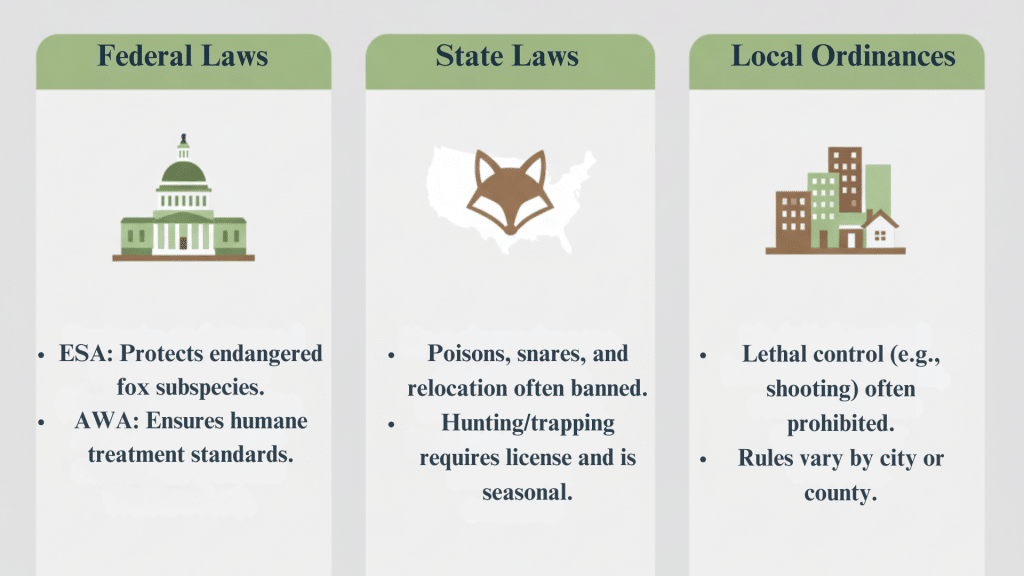Foxes are digging up your lawn again. Your bins are scattered across the driveway. Maybe you’ve even lost chickens to these clever nighttime visitors.
Garden foxes aren’t just annoying; they can cause significant damage to property and pose a threat to small pets.
However, many people are unaware that harsh methods, such as poisons or traps, often backfire and create even bigger problems.
The good news? Proven techniques can effectively deter foxes without harming them or violating wildlife laws.
These methods work by removing what attracts foxes in the first place, then creating barriers they can’t cross.
This guide covers why foxes visit gardens, humane deterrent methods, common mistakes, long-term prevention strategies, approaches that are illegal, and why neighborhood cooperation makes all the difference
Why Foxes Visit Your Garden?
Foxes appear in gardens for five primary reasons. They’re smart animals that know where to find easy meals and safe spots. Understanding what draws them helps you tackle the problem at its source.
- Food sources: Foxes have sharp noses and can detect food from a considerable distance. Open bins, pet bowls left outside, and compost heaps are like dinner invitations to them. Bird feeders that spill seeds also create opportunities for birds to feed.
- Shelter: Every fox needs a safe place to rest and raise babies. Gaps under sheds, thick bushes, and wood piles make perfect hideouts. These spots offer protection from the weather and other animals.
- Livestock and pets: Small animals trigger a fox’s hunting instincts immediately. Chickens, rabbits, and guinea pigs are easy targets if left unprotected. Even the smell of these animals can draw foxes from nearby areas.
- Water sources: Foxes get thirsty, especially during hot summer days. Ponds, bird baths, and pet water dishes provide easy access to drinking water. Garden sprinklers and leaky hoses also create water attractions.
- Easy digging grounds: Soft soil feels great under fox paws for digging. Fresh turf, garden beds, and recently watered areas are perfect for hunting worms and insects. Foxes also dig to create dens or bury food.
Fox Deterrent Methods Side-by-Side
Here’s a quick look at the most effective humane fox deterrents, comparing their effort level, best use cases, and long-term results.
| Method | Best For | Effort Level | Long-Term Effectiveness |
|---|---|---|---|
| Secure bins & food | Urban homes | Low | High |
| Protect poultry | Rural/suburban | Medium | Very High |
| Fox-proof fencing | Large properties | High | Very High |
| Repellents & scents | Small gardens | Low | Medium |
| Motion-activated devices | Night visits | Medium | High |
| Remove shelter | Sheds & gardens | Medium | High |
| Less attractive environment | All areas | Low | Medium |
7 Humane Methods to Deter Foxes

These seven methods are effective without harming foxes or violating wildlife protection laws. Each technique targets different fox behaviors and needs. The best results are achieved by combining multiple approaches.
1. Secure Rubbish and Food Waste
Foxes remember good food spots and return night after night. Your bins might smell normal to you, but foxes can detect food odors from blocks away. Once they find an easy meal, they’ll keep coming back for more.
- Use animal-proof bins with lockable lids – Regular bins are no match for determined foxes. They can flip lids, tip containers, and squeeze through small gaps.
- Keep compost in secure containers – Open compost piles attract foxes, which are drawn to fruit scraps and vegetable waste. Closed systems keep smells contained and foxes out.
- Bring pet food and bird feed indoors at night – Leaving food bowls outside is like putting up a “foxes welcome” sign. Even empty bowls can smell tempting to hungry animals.
This method works because it removes the main reason foxes visit gardens in the first place.
2. Protect Poultry and Small Pets
Foxes see chickens, rabbits, and guinea pigs as easy prey. Their hunting instincts kick in the moment they spot or smell these animals. Standard chicken wire won’t stop a determined fox from getting inside.
- Build fox-proof enclosures using welded mesh – Welded mesh is much stronger than chicken wire and has smaller gaps. Foxes can’t bite through it or squeeze their heads inside.
- Bury fencing at least 12 inches deep – Foxes are excellent diggers and will tunnel under surface-level barriers. Deep fencing stops them from digging their way in.
- Add secure roofs or overhead netting – Foxes can jump surprisingly high and climb well. Open-top enclosures give them easy access from above.
This approach creates physical barriers that foxes cannot break through or bypass.
3. Install Fox-Proof Fencing
Regular garden fencing is designed to mark boundaries, not stop wildlife. Foxes can jump 6 feet high and squeeze through gaps smaller than you’d expect. Standard fencing gives property owners false security against determined foxes.
- Opt for fences 6 feet or taller with tops angled outward. The height stops foxes from jumping over, while the angled tops make climbing nearly impossible. The outward angle throws off their balance when they try to scale it.
- Use electric poultry fencing for extra security – Low-voltage electric fencing gives foxes a harmless but memorable shock. They quickly learn to avoid the area completely.
- Regularly check for weak spots or dug areas – Foxes are persistent and will test fencing for weaknesses. Monthly inspections catch problems before foxes find them.
Proper fencing creates a complete perimeter defense around your property.
4. Use Repellents and Scents
Foxes rely heavily on their sense of smell to find food and avoid danger. Strong scents can overwhelm their sense of smell, making areas unpleasant to visit. Natural repellents are safer for pets and wildlife than harsh chemicals.
- Scatter citrus peels, coffee grounds, or vinegar around entry points – These common household items create strong odors foxes dislike. Used coffee grounds are free from most cafes and work especially well.
- Apply commercial repellents certified safe for pets and wildlife – Professional products are designed specifically for fox control. Look for labels that guarantee safety around children and domestic animals.
- Try predator urine substitutes, such as wolf or coyote scent. Foxes fear larger predators and will avoid areas that smell dangerous. Synthetic versions work just as well as real predator urine.
Scent-based deterrents work 24/7 and cover areas where physical barriers aren’t practical.
5. Motion-Activated Deterrents
Foxes are naturally cautious animals that avoid surprises and sudden movements. Motion-triggered devices catch them off guard and create negative associations with your garden. Most foxes will avoid areas where they’ve been startled before.
- Motion-activated sprinklers spray water when triggered. The water sprays are completely harmless but highly effective at scaring foxes away. The sudden noise and cold water create an unpleasant experience that foxes remember.
- Ultrasonic devices emit high-pitched sounds that foxes dislike. These sounds are above the human hearing range but annoying to fox ears. Solar-powered versions operate continuously throughout the night without requiring electrical connections.
- Solar lights with motion sensors startle night visitors – Bright lights suddenly turning on frighten nocturnal foxes. LED versions are energy-efficient and can run for months on a single charge.
Motion deterrents are most effective in high-traffic areas, such as garden entrances and feeding spots, where foxes are commonly found.
6. Remove Shelter Opportunities
Foxes need safe places to rest, hide from predators, and raise their young. Gardens offer many potential den sites that homeowners don’t notice. Removing these options forces foxes to look elsewhere for shelter.
- Block holes under sheds and decking with mesh or gravel – These dark, quiet spaces are perfect fox dens. Wire mesh or gravel filling prevents access while still allowing drainage.
- Clear dense shrubs, woodpiles, and clutter – Overgrown areas provide cover where foxes feel safe. Regular garden maintenance removes hiding spots and keeps spaces open.
- Regularly check for signs of digging or denning – Fresh holes, worn paths, and scattered debris indicate fox activity. Early detection prevents established dens from forming.
Shelter removal makes your garden less appealing compared to nearby wild areas.
7. Create a Less Attractive Environment
Sometimes the simplest approach is to make your garden boring to foxes. Small changes in garden management can remove temptations that draw foxes in. Consistency across your neighborhood multiplies the effectiveness of individual efforts.
- Harvest fallen fruit quickly – Rotting apples, pears, and berries attract foxes looking for easy meals. Weekly fruit collection during harvest season prevents food accumulation.
- Avoid leaving toys, bones, or pet items outside – Dog toys and chew bones smell interesting to foxes and may attract them to investigate further. Storage in sheds or garages removes these attractants.
- Coordinate with neighbors for consistent results – Foxes have large territories that cross property boundaries. Neighborhood-wide efforts prevent foxes from simply moving next door.
Environmental management works slowly but creates long-term results that last for years.
U.S. Laws on Fox Control and Deterrence

What Not to Do: Unsafe or Illegal Approaches
While it may be tempting to take drastic measures, certain actions against foxes are unsafe, inhumane, or outright illegal. Here’s what to avoid.
| Action | Why Avoid It |
|---|---|
| Using poisons, snares, or harmful traps | Banned in most regions; causes suffering and risks harming other wildlife or pets. |
| Relocating foxes | Often illegal; causes stress, disease spread, and territorial conflict. |
| Aggressive tactics (chasing, harming) | Creates fear and stress; can backfire and make foxes more defensive. |
| Feeding foxes intentionally | Encourages dependence on humans and increases nuisance behavior. |
| Keeping a fox as a pet | Wild foxes are not domesticated; ownership is restricted or illegal in many states. |
Long-Lasting Ways to Keep Foxes Away
Success with fox control requires ongoing effort and attention to detail. Foxes are smart animals that adapt quickly to changes in their environment. Consistent prevention stops problems before they start.
- Inspect your property weekly for weak points – Foxes constantly test boundaries and look for new entry points, so regular checks catch issues early.
- Adjust methods during breeding season (spring) when fox activity increases – Spring brings hungry fox families and territorial behavior, requiring stronger deterrent measures.
- Encourage neighbors to adopt similar practices for best results – Foxes have large territories spanning multiple properties, so neighborhood cooperation prevents them from simply moving next door.
Conclusion
Foxes are part of the natural ecosystem, but that doesn’t mean you need to share your garden with them.
By combining these humane methods, you can protect your property without harming wildlife or breaking any laws.
The key is consistency: remove food sources, block shelter areas, and apply deterrents on a regular basis.
Most homeowners see results within 2-4 weeks when using multiple approaches together. Remember to avoid illegal methods, such as poisons or traps, which often exacerbate problems.
Start with securing bins and removing food attractants today. Add physical barriers around vulnerable areas next.
Ready to reclaim your garden? Check our related guides on wildlife-proof fencing and natural pest deterrents for complete property protection.














